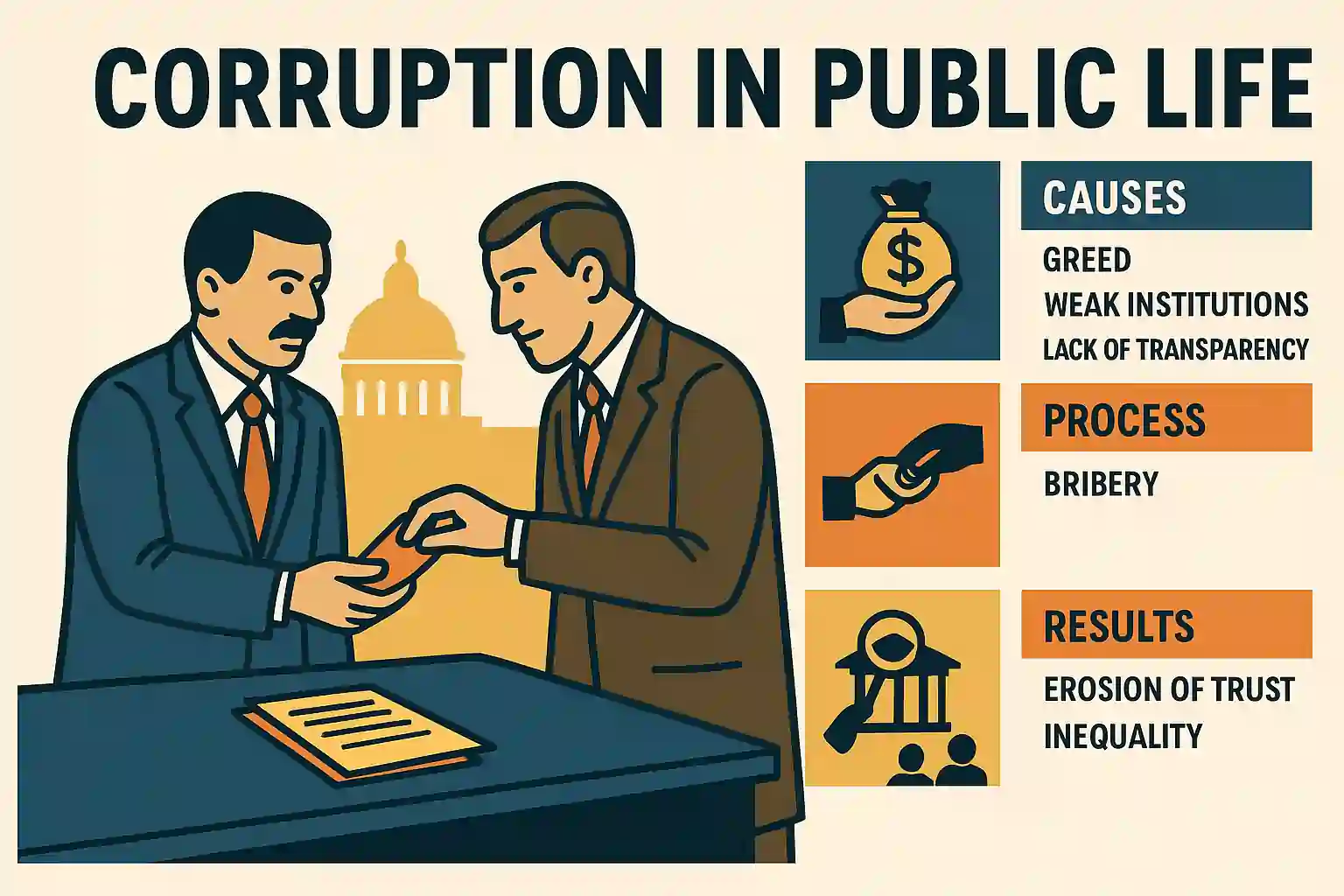Corruption in public life is one of the gravest challenges that democratic societies face today. It is not confined to a particular country or culture; rather, it has become a universal phenomenon that cripples governance, erodes trust, and deepens inequality. In a world where transparency and accountability are the cornerstones of democracy, corruption continues to thrive in multiple forms, leaving ordinary citizens to bear its heavy burden.

The Face of Corruption Today
Corruption is no longer limited to the stereotypical image of bribes exchanged under the table. In today’s globalized scenario, it has evolved into more sophisticated and systemic forms. From inflated contracts in public infrastructure projects to the siphoning of welfare funds meant for the poor, corruption has adapted to modern governance structures.
In India, for instance, despite strong anti-corruption frameworks like the Lokpal Act, Right to Information Act, and digitization of services, cases of financial scams, illegal mining, and manipulation in government recruitment exams regularly make headlines. Similarly, international reports like Transparency International’s Corruption Perceptions Index 2024 continue to rank several developing countries low on accountability, highlighting the persistence of the problem.
Why corruption Breeds?
The bleak reasons for corruption are often embedded in political, economic, and social systems:
1. Concentration of Power – When decision-making is centralized in the hands of a few, unchecked authority often results in misuse.
2. Weak Institutions – Lack of strong legal frameworks, slow judicial processes, and fragile enforcement mechanisms make corruption a low-risk, high-reward activity.
3. Poverty and Inequality – Citizens in desperate need often succumb to bribery just to access their basic rights.
4. Cultural Acceptance – In many societies, giving “speed money” is normalized as the only way to get things done.
5. Political Financing – High election costs push political parties and candidates to rely on corporate donations or illicit funds, which later transform into quid-pro-quo arrangements once in power.
The Process of Corruption:-
Corruption manifests differently at various levels:
- Petty Corruption: Seen in day-to-day transactions—paying bribes for a driving license, ration card, or electricity connection.
- Bureaucratic Corruption: Misuse of power by public officials through red-tapism, nepotism, or favoritism.
- Political Corruption: Large-scale scandals involving embezzlement of public funds, manipulation of policy, or selling of public office for private gain.
- Corporate Corruption: Collusion between private companies and officials, resulting in unfair tenders, exploitation of natural resources, or tax evasion.
The journey of corruption often begins with small acts that become systemic over time, embedding themselves in governance structures until they seem inseparable.
Impact on Public Life
The results of corruption are devastating and multifaceted:
1. Erosion of Trust: Citizens lose faith in government institutions, leading to cynicism and low participation in democratic processes.
2. Stunted Development: Funds meant for infrastructure, health, or education are siphoned off, leaving projects incomplete and citizens deprived.
3. Deepening Inequality: While the rich and powerful manipulate the system, the poor are left to struggle for their basic rights.
4. Brain Drain: Talented youth migrate in search of merit-based opportunities, weakening national growth.
5. Social Tensions: When corruption intersects with caste, religion, or regional politics, it fuels discrimination and unrest.
The collapse of trust and fairness in public life is perhaps the most long-lasting scar corruption leaves behind.
Why Anti-Corruption Reforms Fail?
Despite numerous commissions, watchdogs, and legal frameworks, corruption reforms often fail. The reasons are telling:
- Political Interference: Investigating agencies are rarely independent, and cases against powerful individuals are buried under influence.
- Cosmetic Changes: Reforms often address symptoms, like bureaucratic delays, but ignore deeper issues like electoral financing.
- Public Apathy: Citizens, frustrated by slow systems, sometimes become passive participants in corruption rather than resisting it.
- Loopholes in Technology: Digital governance systems reduce face-to-face bribery, but scams like online frauds or manipulation of e-tenders prove corruption adapts to technology too.
The Way Forward
Tackling corruption requires a multi-dimensional approach:
- Strengthening Institutions: Making watchdogs like the Lokpal and CVC independent of political control.
- Transparent Political Funding: Strict monitoring of election spending and donations.
- Public Participation: Empowering citizens through RTI, whistle-blower protection, and civic education.
- Digital Vigilance: Using blockchain and AI for transparent transactions and tamper-proof governance.
- Cultural Change: Building values of honesty and integrity through education, family, and community leadership.
Conclusion
Corruption in public life is not just a moral failure; it is an economic, social, and political disease that stunts the growth of nations. In today’s scenario, where global economies are interconnected and citizens are increasingly aware of their rights, the tolerance for corruption is shrinking. Yet, unless reforms move beyond paper and truly address the root causes—political greed, institutional weakness, and public apathy—the dream of a corruption-free society will remain distant.
The fight against corruption is not just the responsibility of governments but also of citizens, businesses, and civil society. A cleaner public life is possible when accountability becomes a shared value, not just a legal obligation.
